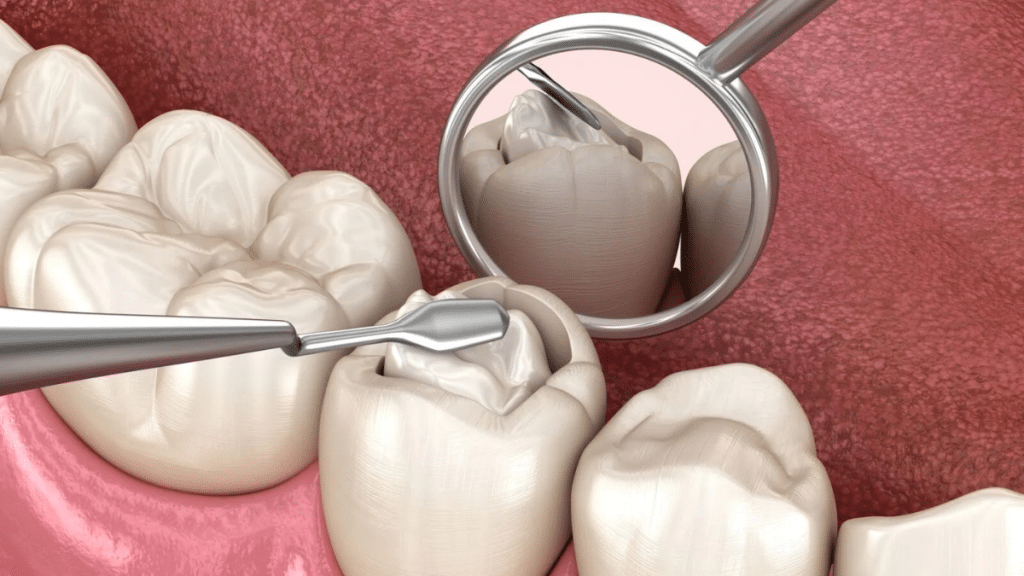Tooth-colored fillings have transformed the way dental restorations are performed. No longer are patients limited to silver amalgam or unsightly metal options. With advancements in materials, techniques, and digital tools, composite and ceramic fillings have emerged as the two most reliable and aesthetic choices. But which one is better for your needs?
Both materials are designed to blend seamlessly with natural enamel while offering strength and protection. However, the differences in how they are applied, how long they last, and their costs can significantly influence your decision.
What Are Composite Fillings?
Composite fillings are crafted from a mix of resin and finely ground glass particles. They’re applied directly into the cavity and shaped while soft, then hardened using a curing light. This makes them incredibly versatile for small to medium-sized cavities, particularly in the front teeth.
What sets composite apart is its ability to bond chemically to the tooth. This means less natural structure needs to be removed, which makes the procedure more conservative. The result is a filling that not only looks natural but also supports the remaining tooth structure.
For cosmetic concerns like minor chips, cracks, or discoloration, composite fillings are ideal. They are also relatively affordable and can be completed in one visit. Many patients seeking efficient and aesthetic solutions especially for smile-centric repairs turn to practices like a Dental Clinic, where front-tooth aesthetics often take center stage.
The Strength and Durability of Ceramic Fillings
Ceramic fillings are made from high-strength porcelain and are known for their exceptional durability and stain resistance. Unlike composites, ceramic restorations are fabricated outside the mouth and then cemented into place using dental adhesives. They are typically used in cases involving larger cavities or heavy bite pressure, such as on molars.
Ceramic mimics natural enamel in its translucency and strength, making it both visually appealing and highly functional. It doesn’t absorb stains like composite might and is far more resistant to wear and tear, especially for patients who grind their teeth or have extensive dental work.
Though they come at a higher cost, ceramic fillings often last 10 to 15 years or more with proper care. For many, this long-term reliability outweighs the initial investment.
Aesthetic Differences and Functional Use
While both materials offer cosmetic value, ceramic has a slight edge in replicating the natural sheen of teeth. Its ability to reflect light in a way similar to enamel gives it a lifelike quality that holds up over time. Composite, while still highly aesthetic, may lose its polish or stain slightly over the years, especially with exposure to coffee, tea, or smoking.
When deciding between the two, it’s essential to consider where the filling is going and how much pressure it will need to withstand. Composite is often ideal for front teeth and smaller areas, whereas ceramic is better suited for chewing surfaces or areas requiring a strong, permanent restoration.
The Role of Cost, Convenience, and Visit Frequency
Another point of differentiation is procedure time and cost. Composite fillings are more budget-friendly and usually completed in a single sitting. Ceramic fillings require a more detailed fabrication process, often involving two visits unless in-clinic milling is available. While this adds time and cost, the payoff is in longevity and strength.
Patients who prioritize convenience or are managing multiple treatments at once may lean toward composite for quick fixes. Those focused on durable, lasting results may find ceramic a better fit particularly when restoring teeth with old or failing fillings.
Advanced Training and Evolving Materials in Dentistry
As materials continue to improve, so do the skills required to place them. Today’s dentists are increasingly turning to focused, accelerated learning to keep pace with changing patient expectations. One growing trend is accelerated implant training, which allows practitioners to quickly master advanced restorative techniques, including ceramic inlays and implant-supported fillings.
These fast-track programs are designed to elevate practical expertise without requiring years of additional study. They are especially useful in high-demand clinical settings where function and aesthetics must go hand in hand. The result is a growing number of practices equipped to deliver high-end restorations with both speed and precision.
Long-Term Considerations and Sensitivity
When it comes to biocompatibility, both materials are safe and widely used in modern dentistry. Ceramic is considered completely inert, making it suitable for patients with sensitivities or allergies. It also doesn’t conduct heat or cold, which can be beneficial for individuals with temperature-sensitive teeth.
Composite, while slightly more porous, remains a safe and effective material when used in the right context. However, its tendency to absorb staining compounds and its slightly shorter lifespan make it better suited for low-pressure, visible areas of the mouth.
Making the Right Choice for You
Choosing between composite and ceramic isn’t a matter of one being better, it’s about what’s best for your specific situation. Your dentist will evaluate the cavity’s size, tooth location, bite pressure, aesthetic goals, and long-term expectations before recommending the ideal solution.
For example, someone undergoing restorative treatment at a Dental Clinic in Gurgaon, particularly for a molar restoration or previously damaged tooth, may benefit more from ceramic due to its enhanced structural integrity and wear resistance. These restorations provide peace of mind in high-stress zones, minimizing the need for future interventions.
Final Thoughts
Tooth-colored fillings offer more than just an aesthetic advantage. They protect your teeth, preserve structure, and restore function all while blending in naturally. Both composite and ceramic have their place in modern dentistry, and choosing the right one depends on your individual needs, lifestyle, and long-term oral health plan.
Discussing your goals with a qualified dentist is the first step in making an informed decision. Whether you’re after a quick fix or a lasting solution, the right material, in the right hands, can help preserve your smile for years to come.
